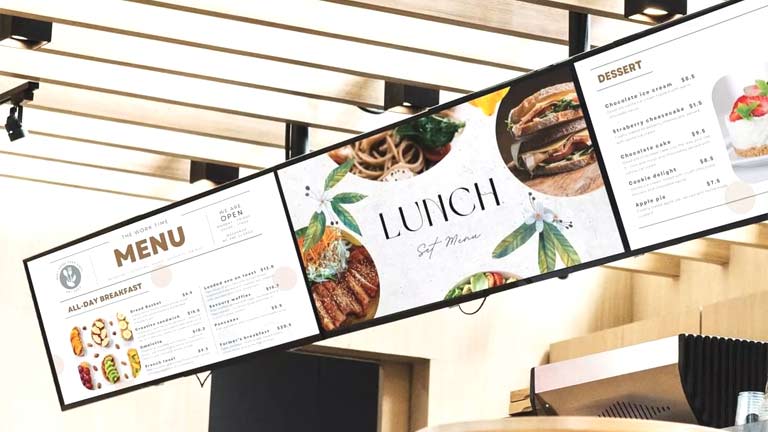
Using lighting control systems, digital signage can create brilliant in-store displays
If you are trying to advertise your business, there are a lot of different avenues that you can take. One of the most widely used advertising techniques is still one of the top choices for many businesses – signs. While we might think of billboards as the type of signage most commonly used by businesses trying to get the word out, digital signage is actually becoming the better option for companies both for advertising and in-store applications. Beyond advertising, there are a lot of other ways that digital signage can be used to make your customers’ experience easier, communicate important information about your business, and even create immersive branded experiences.
For those who are interested in learning more about how digital signage works – you’re in luck! We’re going to be going over why so many companies are introducing digital signage concepts in their business. Plus, we’ll be discussing the commercial control systems that power these digital signs and help companies create unique branded graphics. Let’s get started by finding out what makes these digital signs so popular!
What is Digital Signage and Why is it So Widely Used?
Digital signage relies on a lighting control system to display changing, custom graphics
Digital signage is perfect for helping people navigate confusing buildings.
Let’s start with the basics – digital signage is any type of sign used by a business that operates electronically. We encounter digital signage every day – no matter where we live. Whether it is a simple scrolling LED sign or something as complex as the digital billboards in Times Square – all of it falls under the digital signage umbrella.
Digital signage has a lot of advantages over static signs, which is why it is so popular among companies looking for branding opportunities. The signs respond to the commands of a lighting control system that communicates the different text, videos, graphics, layout, and brightness to the LED, LCD, or plasma display. Once the information is communicated to the sign, the sign decodes the information so that it is displayed correctly.
Truly anything can be displayed using digital signage. With a robust lighting control system, digital signage can communicate advertisements, important customer information, and sales, or help create a better in-store experience. If a business can create a visually appealing graphic as part of a campaign, that graphic can be integrated into its digital signage.
In contrast, before digital signage, we used static signage. These were either banner that was illuminated using high-powered lights or neon signs. While these older types of signage have their place, digital signage is proven to be more flexible and eye-catching. Since we are taking in so much information every day just by walking or driving around, it is important that businesses do everything they can to stand out. Since digital signage can display ever-changing illuminated graphics, it is more attention-grabbing than its predecessors.
How Can Businesses Use Digital Signage Beyond Billboards?
There are so many different ways that lighting control systems can be used to create unique digital signage – let’s take a look at some examples!
Touch screen ordering helps manage lines and creates a better customer experience.
Now that we know why digital signage is used, we should take a look at the different ways that businesses can use digital signage to further enhance their brand and customer experience. The applications for digital signage go far beyond just advertising, so let’s explore some of the more unique use cases.
Digital Menus – For restaurants or bars with frequently changing menus, digital signage is perfect for instant updates. For example, if you run a bar with a constantly changing beer/wine/cocktail list, you can easily change the menu display from a computer connected to the lighting control system. That way, you are never displaying outdated information to customers.
Sales Floor Displays – Sales floor displays are perfect for retail stores that want to do more to entice customers than simply hanging up promotional signs. These sales floor displays are generally smaller and placed in the sales display near specially promoted items. These screens can display new sales information, promotional images, and more! These displays can also be changed instantly as sales are updated and seasonal holidays begin.
Touch Screens – We’ve all been well-conditioned to touch screens at this point. After all, we use touch screens and smartphones to communicate with each other! That means introducing a touch screen in a retail or restaurant setting will help guests navigate the space. For example, if you are operating a grab & go restaurant, you can allow customers to order either at the counter or by using a touchscreen. That way, you can mediate lines and create a better, more efficient experience for guests.
Sales Counter Screens – Screens positioned by sales counters can help promote last-minute purchases. When screens are positioned near a sales counter, they attract customers’ eyes while they are waiting to pay for their purchases. While they are waiting, they can be informed of sales on inexpensive add-ons that can be easily added to their existing bag of items. This helps promote overall sales and gives customers something to look at while they wait.
Overall, these different applications for digital signage are perfect for businesses that are searching for new ways to boost their sales and create exceptional customer experiences.
How Are Businesses Benefiting From Digital Signage?
There are a lot of benefits that come with using digital signage including better visual appeal and easy updates
Keep your information up to date with digital signage.
Now that we’ve covered how businesses are using digital signage to enhance their brand, let’s take a look at some of the benefits that come with using digital signage over static signage. Even smaller businesses with tight budgets can benefit from inexpensive digital signage applications. Here are a few examples of the most common benefits of using digital signage:
Correct Information – One of the most frustrating things that can happen as a customer is being presented with incorrect information. This happens all too often with static signs that need to be manually changed. Businesses change their hours, sales, menus, and general policies all the time, which means signage needs to be changed regularly as well.
Easy to Update – Jumping off of our previous point, digital signage is far easier to update than static signage. From a restaurant perspective, it is far easier to change a whole menu using commercial control systems than it is to manually change out the lettering and graphics. In most cases, all it takes to update digital signage is a working knowledge of the signage management system – no ladders or individual letters are required!
Aesthetics – We’ve all visited a business where they have the old prices covered up with masking tape. While there’s nothing wrong with doing this – it is not the most aesthetically pleasing way to update your company information. To avoid getting out the masking tape and marker every time the menu options change, you can create an impressive digital menu that stays visually appealing no matter how many updates are needed.
First Impressions – When someone interacts with your company, you want to make sure they get a good first impression so they will trust your business in the future. Using digital signage, you can display videos, change images, slideshows, or any other kind of display that will impress your customers. Using digital signage also conveys that your business is modern and forward-thinking.
While we may still think of digital signage as only for advertising and billboards, there are a lot of other applications that can be used to enhance branding and customer experience. These digital signs allow businesses to remain constantly up-to-date while remaining aesthetically appealing to customers. Expect to see more and more uses for digital signage as companies ditch their old signage for advanced alternatives.




